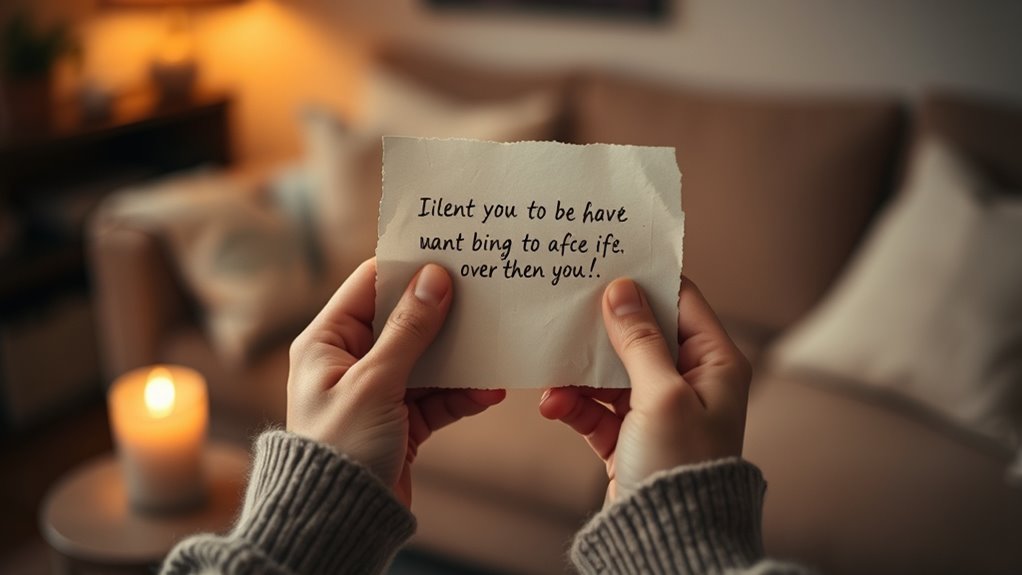To say sorry effectively, recognize that people have different apology languages: some value sincere gestures like heartfelt hugs or notes, while others prefer verbal acknowledgments that honestly admit fault. Tailoring your approach by combining meaningful actions with genuine words shows you understand their emotional needs. The key is sincerity and connecting with what matters most to them. Keep exploring, and you’ll discover how customizing your apologies can lead to stronger, more authentic reconciliation.
Key Takeaways
- Tailor your apology to the recipient’s preferred method, balancing verbal acknowledgment and meaningful gestures.
- Use specific, sincere language to acknowledge the fault clearly and demonstrate genuine remorse.
- Incorporate heartfelt actions, like gestures or notes, to reinforce your words and show real commitment.
- Communicate calmly and attentively to ensure your apology resonates emotionally and meets individual needs.
- Combine verbal and non-verbal elements for a more impactful, personalized apology that fosters trust and understanding.

When someone wrongs you, a sincere apology can go a long way, but not all apologies land the same. Some people respond better to specific gestures or words, which is why understanding apology languages can make a big difference. If you want your apology to truly resonate, it’s essential to recognize what kind of apology the other person values most. For many, sincere gestures and verbal acknowledgment are key components of a genuine apology.
Sincere gestures might include actions that demonstrate you’re genuinely sorry and committed to making amends. It could be as simple as offering a heartfelt hug, a handwritten note, or doing something meaningful that shows you care. These gestures serve as visual proof that your apology isn’t just words but a reflection of your true remorse. When you put effort into sincere gestures, it helps the other person see your sincerity and rebuild trust. Remember, actions often speak louder than words, especially when the person you’re apologizing to values these gestures.
Verbal acknowledgment is equally important for many people. It involves openly admitting fault and expressing regret without deflecting or minimizing the issue. Saying “I’m sorry” might seem straightforward, but what matters more is how you say it. Use a calm, genuine tone, and be specific about what you’re apologizing for. For example, “I realize I hurt you when I said those things, and I truly regret it.” This kind of acknowledgment shows you understand the impact of your actions and are taking responsibility. Avoid vague apologies like “Sorry if I hurt you,” which can sound dismissive or insincere. Instead, be direct and honest, demonstrating your willingness to own your mistakes.
Understanding that different people have different apology languages helps you tailor your approach. Some may need a verbal acknowledgment to feel heard, while others may find sincerity in actions or gestures. Combining both—offering genuine words along with sincere gestures—can be especially powerful. It shows that your apology isn’t just superficial but rooted in real remorse. Recognizing that high-quality communication plays a significant role in effective apologies allows you to better meet the emotional needs of the person you’re apologizing to. When you pay attention to what the other person values most, your apology becomes more meaningful and effective.
Frequently Asked Questions
How Can I Identify My Own Apology Language?
To identify your apology language, pay attention to how you naturally express remorse. Notice if you use non-verbal cues like eye contact or a hug, or if emotional expression through words feels more genuine. Reflect on how you prefer to receive apologies—do you value actions, words, or gestures? Recognizing these patterns helps you understand your unique way of saying sorry, making your apologies more sincere and effective.
Can Understanding Apology Languages Improve Relationship Trust?
This question is as important as the sun rising every morning! Understanding apology languages can dramatically boost your relationship trust by strengthening emotional connection and improving communication styles. When you apologize in a way that resonates with your partner, they feel truly understood and valued. This fosters more open, honest conversations and deepens your bond. So, yes—knowing apology languages helps you build a resilient, trusting relationship that can weather any storm.
Are Apology Languages Applicable Across Different Cultures?
You might wonder if apology languages work across different cultures. Cultural differences often influence how people express remorse, creating communication barriers. Recognizing these differences helps you adapt your apologies effectively, showing genuine understanding. By learning what kind of apology resonates locally, you can bridge gaps and foster trust. So yes, apology languages are applicable across cultures, but tailoring your approach guarantees your apology genuinely connects, regardless of cultural variations.
How Do Apology Languages Influence Conflict Resolution?
You realize that apology languages shape how conflict resolution unfolds because they influence how you communicate remorse. Using non-verbal cues like eye contact or a genuine emotional expression shows sincerity, making your apology more impactful. When you tailor your apology language to your partner’s preferences, it helps reduce misunderstandings and fosters trust. This active, intentional approach encourages healing and strengthens relationships, making resolving conflicts smoother and more effective.
What if My Apology Language Differs From Others’?
You might feel like your apology could be lost in translation, and that’s true—cultural differences and emotional expressions vary wildly. If your apology language differs from others’, it’s like speaking different languages in the same room. To bridge the gap, focus on understanding their emotional expressions and adapt your apology accordingly. This effort shows respect and can turn misunderstandings into opportunities for deeper connection.
Conclusion
So, next time you mess up, remember that saying sorry isn’t just about words—it’s about speaking your partner’s language. Ironically, the best apology might be the one they least expect, like a heartfelt gesture or a simple “I was wrong.” After all, mastering apology languages turns even the tiniest misstep into a chance for connection. Because in the end, the art of saying sorry might just be the most valuable language you’ll ever learn.









